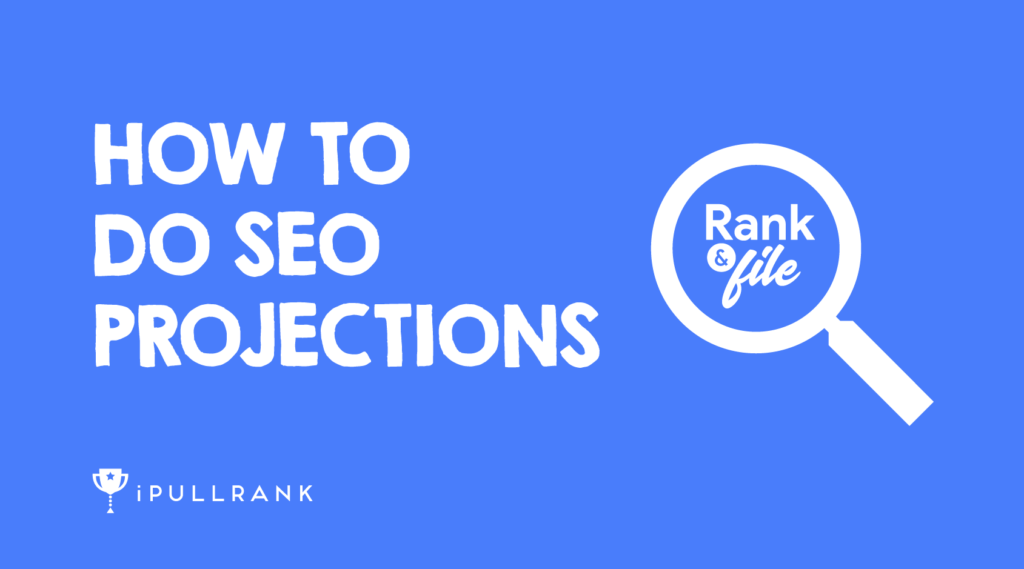Like it or not, there will come a time when someone asks you “what is the traffic opportunity for SEO?” Whether it’s to inform sizing for a product team or to justify an investment to a marketing team, you will be pressed to determine what the traffic and revenue potential for an SEO effort is.
Projections of any kind should be presented with plenty of caveats and disclaimers, but what’s most important is that you have a solid methodology for how to do them.
In this episode of Rank and File, I talk about how to build projections minus the anecdotes. Fire up Google Search Console and Excel and work through this process for your next SEO project.
Video Transcription
Intro
Greeting and salutations, ladies and gentlemen. Welcome back to another edition of Rank and File. I’m your host, Mike King. Today I want to talk about SEO projections. Now, if you’re in this space and you’ve been in this space for awhile, you know the SEO projections are difficult. They’re difficult because you can’t really believe in them.
But the reality of it is that your boss still wants them, so you’re still gonna have to do them right? And everyone wants to get a sense of like, what are you going to expect from this SEO effort? So you have to have a methodology for discovering this. I personally believe that projections based on AB tests tend to be much better than those that come out the way that I’m going to describe to you.
But sometimes you just don’t have the capability of doing an AB test. And even if you do, those are still not perfectly accurate anyway. The reality of it is there’s so many moving parts in SEO and anything could happen where you project something and it just doesn’t go well, and then everybody loses their jobs. I don’t want you to lose your job.
The “Equation”
Okay, so there’s an equation that’s pretty standard as far as I know, you know, as long as I’ve been in SEO, which goes back, wow, 13 years now, a pretty accepted equation. So it was click through rate times search volume times the conversion rate from organic search. That’s what you can expect, that you can get if you rank better for a given keyword, right? And so if you’re in eCommerce, you just add average order value to that as well. And now you have a dollar figure of what can be expected from your organic search effort.
How to compute
Alright, so the way you compute this, the first thing you want to do, and this is the main caveat that I want to offer here, download your CTR data from Google search console. Don’t use an anecdotal CTR that you read in a blog post because it’s not necessarily how your website is performing. So you want to download CTR from Google search console, limiting it specifically to your unbranded terms. So the filter that you put in GSC, on query, make sure you say, does not contain whatever your brand is, right?
And then once you’ve got that in Excel, you want to round the rankings because you know the rankings that come out of GSC are going to be decimal points. That’s not really valuable in this context. So what we’re going to do is basically round it to whatever the number is. Then do a pivot on those rankings versus the average of the CTR. So now what you’re going to get is like, you know, for position one, you’re getting an average of let’s say 40% right? And then so on for the remainder.
And you want to limit that to the top 10, so another thing that you want to do is then compared to the CTR curve for your industry, so advanced web advancedrateranking.com/ctrstudy, they show you what the a click through rate curves are looking like across a variety of different industries.
You can pull that for the last month or whichever month that you care about and then compare that to what you’re seeing so you can get a sense of like, okay, how are other people performing? Are we doing better with our website? Are we doing worse? And that then gives you an opportunity to determine is there more opportunity for us to improve by adjusting our metadata and so on.
So at this point you want to pull keywords that you don’t rank in the top ten for. So you use a tool like SEMrush or any of the other tools out there that can give you that data. Searchmetrics also comes to mind. Then segment those keywords down to the ones that are going to have a specific commercial intent. Your awareness keywords aren’t going to be super valuable here unless your only goal is traffic. But if we care about what the business a result is going to be from these efforts, then you’re going to want to limit it to those keywords that have that more commercial intent.
At that point, once you’ve got your keyword set, aggregate those into what the search volume is for those sites. So let’s say you’ve got 50 keywords and the aggregate search volume is 100,000, that’s the value that you’re going to use for computing your projections. Then go down that whole model that you built, that whole CTR curve.
So for number one position, like I said, it might be 40% multiply that, build that whole equation that we just talked about, using that search volume number and then also that conversion rates specifically from organic search, you don’t want the whole site from all channel conversion rate. You specifically want it from organic search.
And at that point you now have a range for what your projections would be. So based on getting every keyword in the top 10, you have a number which is X. Everything in it to the number one position, you have a number, which is Y. So that is now your projected range.
Conclusion
And you know, I do want to be careful here, make sure that you’re being very conservative with the numbers that you’re sharing. You know, make a determination using perhaps a keyword difficulty to determine how many keywords you actually can expect to get into the top 10 and then use that as your searing pan to determine what your projections are going to be. That’s all I got for today. Hope it helps. See you next time.

Your turn. How do you approach projections for SEO?





